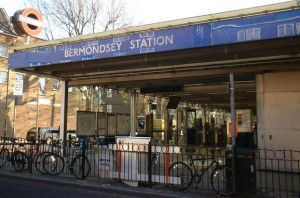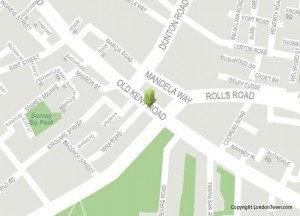Early January, and I am in the process of finalising the fieldwork that I have been carrying out in two neighbourhoods in Southwark during much of 2011. The final interviews have been set up, and we are in the process of organising neighbourhood forums in Bermondsey and Camberwell in order to discuss our findings with research participants and local stakeholders.

Bermondsey tube station. Photo taken by A. Brady
The fieldwork is part of an EU-funded research project called Concordia Discors. Partner organisations in Germany, Hungary, Italy, Spain and Britain are carrying out similar projects at neighbourhood level in Nuremberg, Budapest, Turin and Barcelona, exploring how local residents experience integration and inter-group relations.
A word on the methodology. The approach chosen for Concordia Discors is an open-ended and multi-facetted one, exploring the neighbourhood through interviews, participation in local events and analysis of items in local newspapers, thus building up a broad understanding of neighbourhood relations as well as the broader socio-cultural back-drop. It is thus an approach that demands more of the individual respondent who is asked to share his or her experiences, often the memories of a life-time. Needless to say, it is also very worthwhile, a privilege really, to be carrying out these interviews, collecting and analysing a wide range of stories.
The following is basically a snapshot, based on the first analysis of my interviews from Bermondsey, a neighbourhood in the northern part of the London Borough of Southwark. It is first and foremost meant to illustrate how local dynamics and boundaries in an urban setting change over time.
Urban change in Bermondsey
‘If you want to experience the real Bermondsey, you should go to a funeral’. This was the advice of a stall-holder on The Blue, the market square that is the traditional hub of the local community in South Bermondsey. And local funerals are big events, with large numbers of people turning up, and with elaborate flower decorations. Along a similar vein, ‘Last Orders’ – Graham Swift’s 1996 novel about four men’s journey from Bermondsey to the coast of Kent in order to spread the ashes of their deceased friend in the sea – has got this feel of intimate and very local social relations but also finitude as that joint history, based on wartime memories, the local pub and local jobs, is falling apart, with families fragmenting and moving out.

Old Kent Road
There is also an element of sadness here. Is the implication that with each funeral another bit of ‘real Bermondsey’ dies? It does, because the ‘real Bermondsey’ that is remembered was that of a close-knit community, based on local jobs in the docklands, and with the extended family – aunts, uncles, cousins – often living in the immediate vicinity. It is a closeness that also resulted in a very strong territorial identity, a them versus us with the Old Kent Road as the boundary, but otherwise perhaps expressed most strongly in the slogan of Millwall, the local football club: ‘No one likes us, we don’t care’.
In a sense ‘real’, close-knit Bermondsey started unravelling in 1965 when the metropolitan borough of Bermondsey became part of the London Borough of Southwark. As a result, outsiders gained access to housing in Bermondsey, and over time it became increasingly difficult for Bermondsey-born residents to find housing in the neighbourhood. And to this day, access to affordable local housing remains a cause of local concern and frustration.
At the same time the mix of people in Bermondsey has changed significantly. Whereas Bermondsey was known as a largely white working class neighbourhood, with the Irish as the biggest minority population, increasing numbers of outsiders have over the past decades moved into Bermondsey. By 2001, non-white immigrants and ethnic minorities constituted approximately one third of the total population in the area, with West Africans comprising the biggest minority group.
This considerable and relatively sudden influx of immigrants and ethnic minorities have resulted in tensions between majority and minority populations, in particular in relation to the allocation of council housing. But while Bermondsey has been used as a venue for BNP and EDL marches up into the early noughties, the local perception is that racist manifestations in the neighbourhood have been, if not erased entirely, then certainly become less prominent over the past 10 years. As experienced by a community worker who had worked in Bermondsey for 13 years: ‘It used to rise and fall, but at one stage, you know, Monday morning’s job was to, you know, wipe the wall again. But now, I think there still is racism, you still come across people with racist attitudes, but it is not as overt. I think on the whole people get on with each other.......Sometimes the attitudes of black British second or third generation towards incoming populations can be quite difficult’.
Despite the growing numbers of immigrant and minority residents in Bermondsey, the most significant change may be the way in which the former docklands – the mainstay of local livelihoods – since the late 1980s have been redeveloped into exclusive residential areas. These are gated communities attractively located near the riverfront and close to the city of London, but also adjacent to deprived nearby council estates. But despite this spatial proximity, residents of the new developments are seen as having very limited involvement with Bermondsey. This resonates with the description of Bermondsey in Saturday’s Guardian: ‘A tale of two cities: it is either hyper-gentrified or hyper-ungentrified, and never the twain shall meet. This makes for a peculiar patch of city where poverty and affluence jar’ (14.01.12). Or as a resident on the Dickens Estate, immediately next to the developments, put it: ‘They’ve got their wine bars – we’ve got our pubs’.
It is, rather than ethnic and racial markers, this very pronounced socio-economic disparity which, in the eyes of many local residents, constitutes the biggest divide in today’s Bermondsey.